Wed, 29 Apr 2015 . Last updated Mon, 01 Jun 2015 14:27


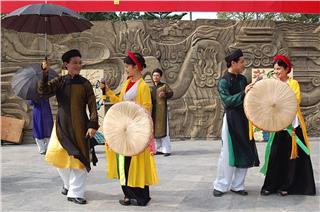
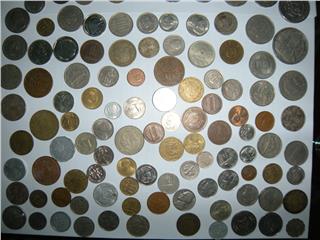
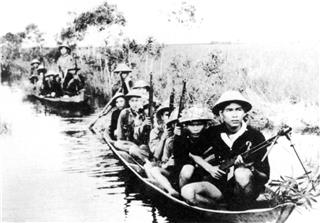
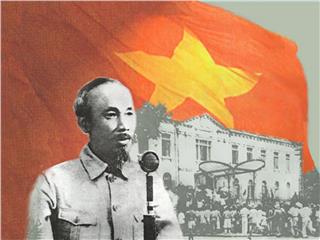
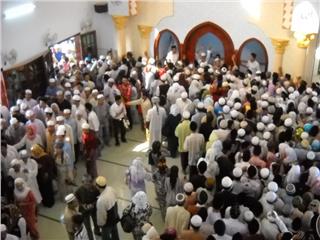

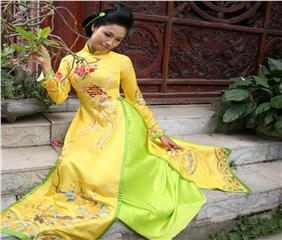
Among many genres of traditional folk singing existing for thousands of years such as “cheo” singing of Thai Binh and Nam Dinh, “cheo tau” singing of Ha Tay, “Giam” singing of Nghe An and Ha Tinh, “ca tru”, Hue folk singing, folk songs of Southern Vietnam, etc., “quan ho” singing (love duets) of Kinh Bac land proves itself to be unique. As some verses go: “Beautiful bamboos grow as individuals. A beautiful girl shows her gracefulness though she stands alone”.
Fine features of “Quan ho” singing can be seen through singers, their nice outfits, graceful gestures, sweet voice, meaningful lyrics and quids of betel or cups of tea, each of which is imbued with humanity and distinctive cultural traits. The blend of sweet singing voice beautiful melodies and lyrical poems bring everyone to the world of friendship, love, human bond and the word of creativity and arts. In other words, “Quan Ho” singing links people with a string of love friendship to be stronger. Facing the mysterious universe with lots of risk, people sing “quan ho” with all their hearts to pray for rain, fortune, love and good luck or to relieve themselves from their bad luck.
“Quan ho” singing was recognized by UNESCO as intangible heritage of humanity in 2009. The land of “quan ho” singing has developed for thousands of years under different names such as “Bac Giang”, “Nhu Nguyet Giang”, “Bac Dao”, “Kinh Bac”, “Bac Ninh”. Under King Minh Menh’s reign, Kinh Bac town was renamed into Bac Ninh town, then in 1831, Bac Ninh town became Bac Ninh province. In 1895, the province was divided into two smaller provinces of Bac Ninh and Bac Giang. In 1962, the two provinces were merged into Ha Bac province. On November 6, 1996, Ha Bac province was divided into Bac Ninh and Bac Giang again.
To thoroughly understand “quan ho” culture, we should consider its cradle, which has existed for thousands of years – Kinh Bac cultural land. According to many researchers, the “quan ho” space in northern Cau river in Bac Giang is very wide. It still has many distinctive values of this kind of singing. In these villages, “quan ho” singing has become part of people’s daily life.
“Quan ho” singing in the Northern part of the Cau river is closely attached to that in the South, creating a special cultural region. The two areas’ “quan ho” singing shares some similarities in the popularity, stability and unity of language and in singing style. This means “quan ho” singing in these areas has a common origin and is a product of local people.
Five out of 49 ancient Kinh Bac villages with “quan ho” singing recognized by UNESCO as intangible cultural heritage of humanity belong to Viet Yen district, Bac Giang province. Each male and female generation in a village often makes up 3-5 “quan ho” groups. “Quan ho” singing is associated with village festivals, which often start on the 4th day of the Lunar New Year and last for 3 months. Some village festivals are also held in the 8th Lunar month. Therefore, spring and autumn are seasons of “quan ho” singing. “Quan ho” singers accumulate experience through a long process of learning about singing styles and customs.
Singers of “quan ho” groups keep practicing until they become professional and capable of singing in all styles. Over the time, the number of “quan ho” singers keeps increasing. “Quan ho” singing is a combination of different genres of folk singing. It has the purity and excitement of “cheo” singing, the allurement of “Giam” singing, they profoundity of “ca tru” and the power of Southern folk singing. However, it is a unique genre of singing with different styles associated with different cultural spaces.
“Quan ho” singing is also performed in worshipping ceremonies, during which groups of signers bring betel, areca nuts, incense, candle and fruits to the communal house to offer to deities. These groups often include both male and female singers. Earlier, girls might not attend worshipping ceremonies, but female singers were allowed to do this. After the ceremonies, they often sing some songs to pray for peace, wealth, good luck, good health and longevity before attending any other events.
Singing in response to a singer’s voice and lyrics is considered complete response. This kind of singing is often of high level because it requires singer’s creativity, deep knowledge about music and poems, and considerable singing skill.
Among ancient “quan ho” villages in Bac Giang province, Huu nghi village in Ninh Son commune, Viet Yen district is appraised as the one having most singers who can meet strict requirements of a professional singing voice. Lying by Cau river, Huu Nghi village has many spiritual buildings constructed in the 17th century, including a temple dedicated to Tam Giang Saint, a temple dedicated to the God of mountain, and the grave of Dao Hoa princess. “Quan ho” singing has been maintained in the village for generations. Many locals now still remember old “quan ho” songs and keep memories about traditional “quan ho” activities. All the singers here are making great efforts to preserve the traditional singing.
“Quan ho” rehearsals are simply organized but give everyone the chance to review old songs and teach traditional melodies to their descendants. Children in Huu Nghi village have listened to “quan ho” songs since their birth. According to cultural researchers, Huu Nghi villagers have made great contributions to preserving traditional “quan ho” singing, especially “quan ho” styles. Thanks to Huu Nghi villagers’ efforts and young people’s passion, ancient “quan ho” melodies will continue resounding in this village. The effort also contributes to preserving ancient “quan ho” melodies in the land of Kinh Bac.
Preserving and promoting this cultural heritage is the responsibility of not only local authority but also of all people in Vietnam and around the world, especially those living by the Cau river and people living in “quan ho” villages. It is the desire to live of Kinh Bac people that inspires them to compose beautiful songs about love and brother hood. Just like of the Cau river which never ends up drying, “quan ho” melodies will never fade no matter how life has gone through and how much the world has changed.
Source: VTC10 - NETVIET

 Đặt vé máy bay cho người Việt?
Bấm vào đây
Đặt vé máy bay cho người Việt?
Bấm vào đây
Our service uses cookies for technical, analytical and marketing purposes. See our Cookie và Privacy policies for more information. If you agree to this, just keep browsing.


